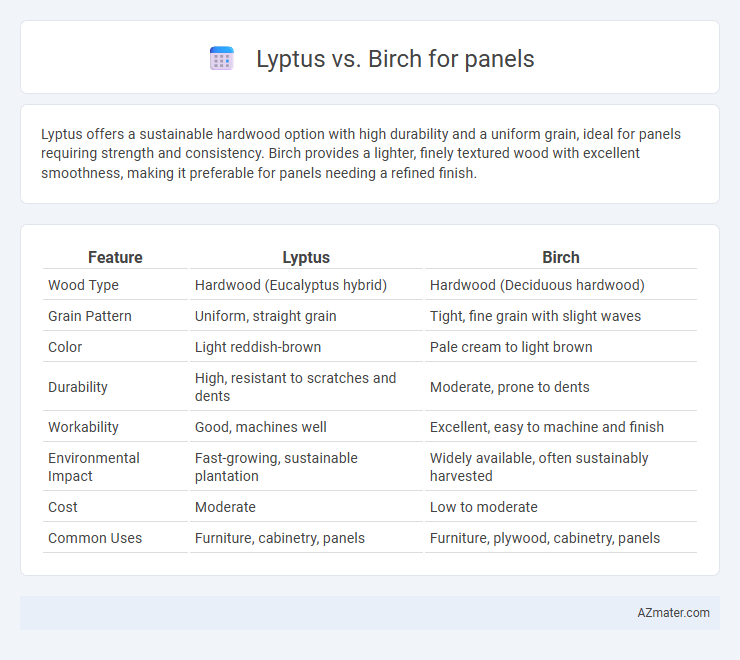Lyptus offers a sustainable hardwood option with high durability and a uniform grain, ideal for panels requiring strength and consistency. Birch provides a lighter, finely textured wood with excellent smoothness, making it preferable for panels needing a refined finish.
Table of Comparison
| Feature | Lyptus | Birch |
|---|---|---|
| Wood Type | Hardwood (Eucalyptus hybrid) | Hardwood (Deciduous hardwood) |
| Grain Pattern | Uniform, straight grain | Tight, fine grain with slight waves |
| Color | Light reddish-brown | Pale cream to light brown |
| Durability | High, resistant to scratches and dents | Moderate, prone to dents |
| Workability | Good, machines well | Excellent, easy to machine and finish |
| Environmental Impact | Fast-growing, sustainable plantation | Widely available, often sustainably harvested |
| Cost | Moderate | Low to moderate |
| Common Uses | Furniture, cabinetry, panels | Furniture, plywood, cabinetry, panels |
Introduction to Lyptus and Birch Panels
Lyptus panels, made from a hybrid eucalyptus species, offer a sustainable and fast-growing alternative to traditional hardwoods, prized for their uniform grain and resistance to warping. Birch panels, derived from deciduous trees native to North America and Europe, provide a smooth, pale surface with exceptional strength and durability ideal for cabinetry and furniture. Both options deliver versatile, high-quality materials suitable for various woodworking and architectural applications.
Origins and Sustainability of Lyptus and Birch
Lyptus wood originates from hybrid eucalyptus trees primarily grown in fast-growing, plantation-based forests in Brazil, designed for sustainable forestry practices that include replanting and minimal use of chemicals. Birch, commonly sourced from natural forests in North America and parts of Europe, undergoes varying sustainability standards often dependent on regional forestry management and certifications like FSC. Lyptus offers a more controlled and renewable supply chain due to its plantation-based origins, while birch's sustainability is linked to forest stewardship and responsible harvesting in natural ecosystems.
Grain Pattern and Aesthetic Differences
Lyptus features a fine, uniform grain pattern with a smooth, consistent texture, offering a contemporary and clean aesthetic ideal for modern paneling applications. Birch showcases a more varied grain with subtle waves and occasional knots, providing a natural, warm appearance that enhances traditional or rustic interiors. The choice between Lyptus and Birch for panels depends on the desired visual impact, with Lyptus delivering sleek uniformity and Birch emphasizing organic uniqueness.
Strength and Durability Comparison
Lyptus panels exhibit exceptional strength and durability due to their dense grain structure and high resistance to wear, making them ideal for heavy-use environments. Birch panels offer notable strength with a fine, uniform texture but generally have slightly less hardness compared to Lyptus, affecting long-term durability under intense stress. Choosing Lyptus ensures enhanced impact resistance and longevity, while Birch provides a balance of strength and aesthetic appeal for moderate-use applications.
Workability and Machining Properties
Lyptus offers superior workability with a fine, uniform grain that reduces tear-out and allows for smooth, precise machining, making it ideal for intricate panel designs. Birch panels provide strong machining properties with consistent density, which supports clean cuts and excellent edge definition but may require sharper tools to avoid splintering. Compared to birch, Lyptus is more stable during machining, reducing tool wear and increasing efficiency in panel production.
Cost Analysis: Lyptus vs Birch
Lyptus panels typically cost less than birch due to faster growth rates and efficient plantation management, resulting in lower raw material expenses. Birch panels, while more expensive, offer higher durability and a finer grain, which can justify the premium in high-end applications. Cost analysis shows Lyptus is ideal for budget-conscious projects seeking sustainability, whereas birch suits those prioritizing premium aesthetics and long-term performance.
Environmental Impact and Certifications
Lyptus wood, a fast-growing hybrid eucalyptus species, offers a more sustainable option for panels due to its rapid regeneration and certification by the Forest Stewardship Council (FSC), ensuring responsible forest management. Birch, although durable and aesthetically appealing, typically comes from slower-growing trees and may lack widespread eco-certifications, resulting in a higher environmental footprint. Choosing Lyptus panels supports reduced deforestation and promotes sustainable forestry practices, aligning with green building standards and environmental certifications such as FSC and PEFC.
Common Applications in Panel Usage
Lyptus is widely used for decorative wall panels and furniture due to its durability and smooth finish, making it ideal for high-traffic commercial interiors. Birch panels are preferred in cabinetry and architectural millwork because of their fine grain and light color, which enhance aesthetic appeal in residential and office settings. Both woods offer excellent workability, but Lyptus provides greater resistance to wear, while Birch excels in environments requiring a clean, modern look.
Maintenance and Longevity
Lyptus wood offers superior resistance to scratches and dents, making it easier to maintain panels over time compared to birch. Birch panels often require more frequent refinishing and careful upkeep due to their softer texture and susceptibility to wear. Longevity of Lyptus is enhanced by its dense grain structure, providing durability and a longer lifespan for high-traffic applications.
Which Wood is Best for Your Project?
Lyptus offers a dense, hard surface ideal for high-traffic panel applications, with natural resistance to wear and a smooth finish suitable for staining or painting. Birch provides a lighter, fine-grained texture that excels in detailed woodworking and offers excellent stability, making it versatile for both decorative and structural panels. Choosing Lyptus benefits projects demanding durability and environmental sustainability, while Birch suits designs prioritizing aesthetic versatility and ease of machining.

Infographic: Lyptus vs Birch for Panel
 azmater.com
azmater.com